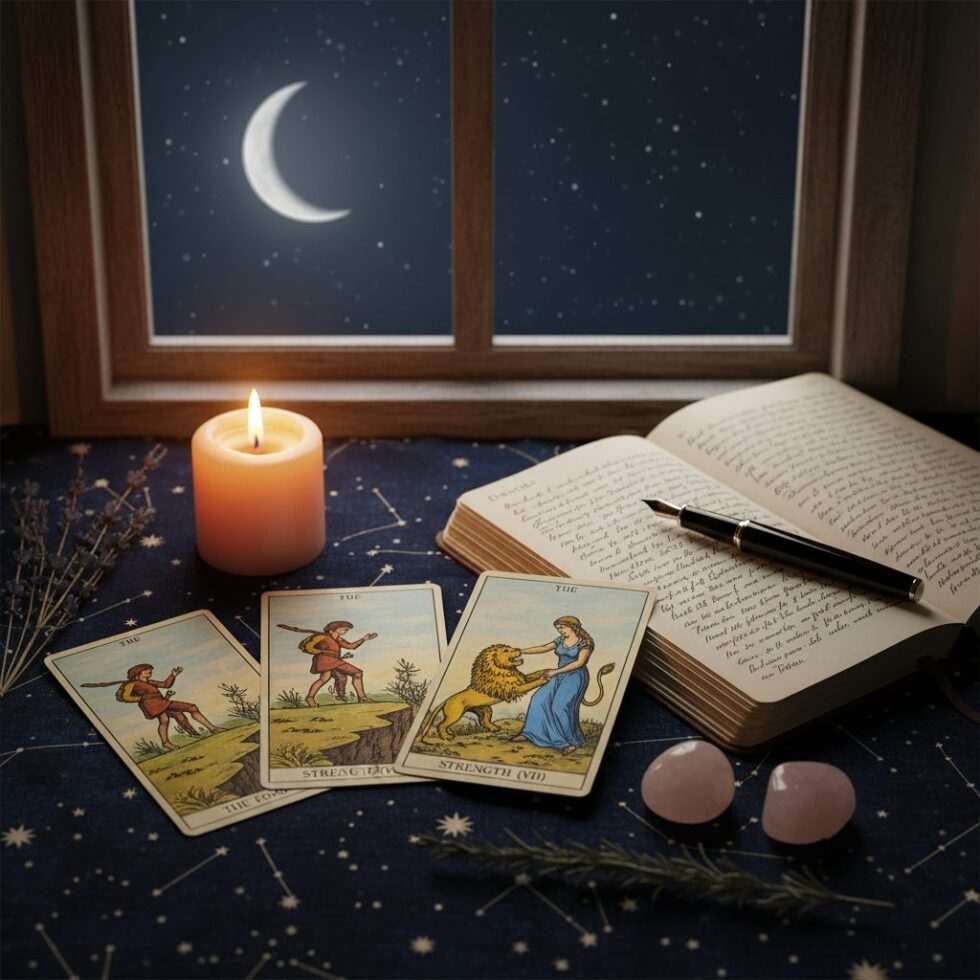My psychic chat
- Home
- Refill my account
- Sign Up
- Log in
- Our blog
Options
- Contact us
- FAQ
- Language
There are the words we write, and the ones we draw. Tarot cards aren’t just here to predict a hazy future or decode a single situation; they have a way of speaking with you. They whisper what your mind won’t say out loud and reflect what your heart already knows.
Every spread is an emotional snapshot, a still of who you are in this moment. But what happens when that snapshot has no caption, no date, no record? It fades. Maybe you’ve pulled a card that felt familiar, like an echo from a reading long ago… but you couldn’t recall when it happened or what it meant. That missing memory leaves a gap.
Enter the tarot journal. It’s more than a notebook and more than fixed interpretations. It’s a living, sacred space where your readings become conversations over time, a bridge from who you were, to who you are, to who you’re becoming. Writing what you experience, feel, understand or sense after a reading anchors the moment. It turns tarot from something fleeting into wisdom you can return to.
Keeping a tarot journal is also a daily act of listening to yourself, card by card, page by page. It helps you trace the invisible threads tying together your questions, your cycles, and your breakthroughs. Perhaps that’s the true power of the cards: not just instant answers, but the story they help you write.

A tarot journal isn’t about lining up cards and memorized meanings. It’s about learning to listen differently, spotting patterns, noticing what’s shifting (and what isn’t). It’s a regular check-in with your unconscious, and your growth.
This journal can take many forms:
The medium doesn’t matter. What counts is the honest relationship you build with your readings.
Because the more you write, the more you see. And the more you see, the more you understand.
A tarot journal helps you:
You don’t need perfect penmanship or a daily practice to keep a meaningful journal. What matters is that the format resonates with you. Here are a few approaches:
Pull one card each morning or evening with a simple prompt like “What energy is with me today?” or “What do I need to understand about this day?” Then jot down:
It’s a simple rhythm that strengthens intuition and keeps your connection to the cards steady.
Use tarot at key moments, new moons, big decisions, or seasons of doubt. In that case, your entry might include:
This format is ideal if you don’t read daily but want to anchor the guidance that matters.
Perfect for exploring the cards themselves. Dedicate one page per card and record:
It’s an intimate way to build a lived, embodied relationship with the Major and Minor Arcana.

A tarot journal isn’t homework, it’s an extension of you, where intuition, reflection, and emotion meet. The most common mistake? Trying to “do it right” and locking yourself into a rigid, academic format. Instead, let your voice lead. Here are prompts and sections you can adapt to your style:
Your journal isn’t the destination; it’s the companion. You don’t have to write everything every time, just keep the conversation between you and the cards honest. Over time, it becomes a mirror that helps you see more clearly, and see yourself more clearly.
A tarot journal isn’t only for big life questions. It can catch the feeling of a moment, illuminate a vague hunch, or mark a milestone. Simple spreads, done regularly, can become meaningful rituals. Their power isn’t in complexity but in how they make your inner world speak. Try these and record them in your notebook:
Each of these spreads is an emotional snapshot. Log them and you’ll build a private gallery of your inner life. When you read back months later, a path appears, rarely linear, sometimes messy, always revealing of your personal evolution.
Emily, 36, holistic therapist
“My tarot journal helped me spot self‑sabotage. Rereading entries, I saw the same card appear whenever I over‑gave. Now I set clearer boundaries.”
Tony, 29, designer
“I never used to write. Journaling after my readings gave me a taste for words. It’s a space where I can be real, no judgment, like talking to an old friend.”
Sophie, 41, career‑changer
“During my career uncertainty, my tarot journal was a lighthouse. Patterns and messages emerged that I’d have missed without writing. I still reread some pages with emotion.”
No, but the more you do, the deeper the connection between the cards and your inner world. Even a few lines once a week can have real impact.
Write your impressions, even if they feel fuzzy. Intuition strengthens with practice. You can always revisit the spread later with fresh eyes.
Not necessarily. Sticking with one deck for a while helps you develop a shared language, but feel free to rotate if that keeps your practice inspired.
Handwriting can deepen intuitive flow, but if digital journaling works better for you, go for it. What matters most is consistency with your style.
You don’t need to wait for the next Full Moon or a big life question. Pick up your deck. Pull a card. Open a notebook or a blank doc. And write.
What did you feel as you pulled it? What does it remind you of? What were you hoping to see, and what does that hope say about you?
A tarot journal isn’t a task, it’s companionship. A gentle, grounded way to walk your inner path. It doesn’t ask for perfection, only your presence.
And if tonight you simply write how this idea makes you feel, that might be the first page of a very personal adventure.